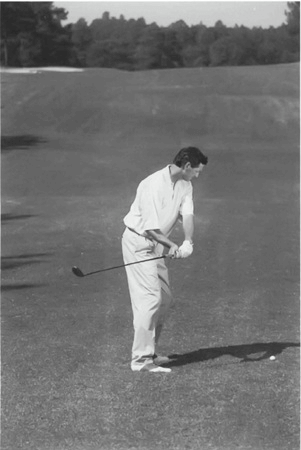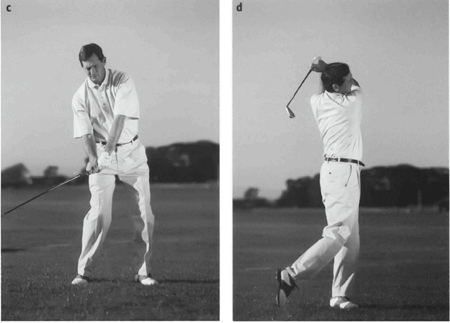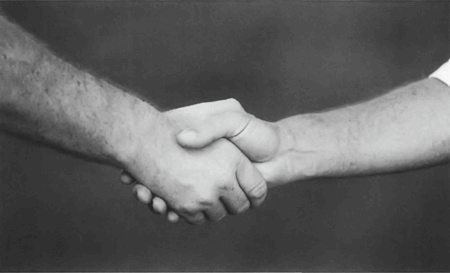The terminology we use in golf when your golf shots go right is called a ‘slice’. As with all shots, you can trace the root cause of your slice.
Table of Contents
Why Do My Golf Shots Go Right?
The cause of your golf shot going right is that the clubface is open or opening through impact. Slicers tend to swing too steeply. What causes the face problem is usually the steep swing.
The reason why your golf shots go right has nothing to do with cutting across the ball. An out-to-in swing path doesn’t cause a slice.
It never has caused a slice. It never will cause a slice. It is simply the characteristic of a slicer. Sure, it can aggravate a slice. But it doesn’t cause it. For example, you can swing across the ball on an arc with the clubface closing and you’ll hit a pull or a pull-hook, not a slice.
So the reason why your golf shots go right isn’t caused by a path mistake. What comes first is the clubface being open. Most likely your swing is too steep coming into the ball and your arms are reverse-rotating to open the clubface.
The clubhead is simply swinging off to the left to try and compensate for the open face. That ends up curving the ball too far to the left
How To Stop Your Golf Shots Going Right?
So where do we start? With the clubface. We have to fix that. Make sure that your grip is strong enough. Make sure that your wrist position at the top isn’t cupped—that opens the clubface and makes the swing more upright.
Given those two factors, if you still slice your swing is almost certainly too steep. Or you are not squaring the back of your left hand at impact.
We need to get rid of that steepness, especially coming into the ball. Most people take the club inside on the backswing, lift it straight up, come down steep into the ball, and block the face open.
That’s one way to steepen the swing. Or the swing is too steep all the way through, up and down. Or you are taking the club back on a good plane and then steepening the downswing. Your problem has to be one of those.
When you are steep you have to find the source.
- Is it the body? Turning the shoulders with too much of a tilting motion.
- Is it the arm swing? Arms going straight up and down.
- Is it taking the club away flat and lifting?
- Is it a cupped left wrist at the top?
- Or are your shoulders starting the downswing, causing the club to come down on too steep an arc?
This can happen even after a good backswing. The cause of your steepness is one of these. Let’s assume the club is moving too much inside on the takeaway.
Typically, one whose golf shots go right takes the club away too much to the inside.

That is the most common problem. Is it happening because your hips, shoulders, and right side are pulling back too fast? That jerks the club to the inside so that you have to lift itup. Are your arms pulling back too much or are your hands turning too quickly to the inside?
All or any of those can cause you to lift the club to the top and then come down too steeply or “over the top.” Analyze, then try to reverse the loop. Get the club swinging back straighter and more up early in your swing. At least that is how it should feel. Your swing will still move the club to the inside of the ball target- line.
But not inside and low. More up and inside. Then let the club go around. So instead of in and up, you have the club moving up and around. The feeling will be that you are almost reversing the loop of your old swing. It’s the same swing, but run in reverse. Instead of back flat and down steep, you are taking the club back a little steeper and down flatter.
The best way to practice this is with the club held a couple of feet up off the ground. Then make practice swings trying to swing the club on a consistent level plane in the backswing, one that is flatter than you would use in golf.
Hold the club off the ground (a), make a “level” turn (b), then swing down (c) and up (d)


When you swing the club down feel like your downswing is under the plane of your backswing more to the right and then up in the through swing. As you swing, feel your shoulders turning and your arms rotating.
Feel the clubface opening and closing. The idea is that you practice this swing with the club off the ground and, as you go, lower the club down to the ground.
The best clubs to use are the 5-iron and longer. A fairway wood is also good because it has more loft than a driver.
And, by the way, always tee the ball up when you are trying to fix an inside and over the top loop. Always. You’ll find it easier to level out your steep approach into the ball. If you get the clubhead swinging on that flatter plane, you are going to be able to square your hands through impact.
There’s no guarantee, of course, but it’s easier. Focus on squaring the back of your left hand at impact. In fact, if you are prone to big slices, try to square the clubface before impact. Take care though. You aren’t trying to turn your hands over, but simply attempting to get the back of your left hand facing the target at impact.
Take a slightly stronger grip, one where the “Vs” formed by your thumbs and forefingers point more toward your right shoulder. You’ll know you’ve gone too far if you start hooking. But before you panic, make sure you are hooking rather than pulling.
If your ball starts to the right and truly hooks, back off toward a neutral grip again. The first goal is to get the ball hooking. Practice off a tee to start with. That will help shallow out your steep swing. Build success by clipping the ball off the tee.
If you start struggling with the ball on the ground, reverse the process. Tee the ball up, or go back to your practice swings with the club off the ground.
There is no time frame. Take as long as you need. Go back to exaggerating the opposite feeling. Feel like you are making the opposite loop. And focus strongly on squaring the back of your left hand. This has to be a conscious thought if you slice.
Grip Pressure
You hear a lot about how all golfers should hold the club lightly, as if holding a bird (I don’t know many people who hold birds, but I do know what they mean).
And yes, it is great advice. Especially for those who slice. The tighter your hold on the club, the less active your hands will be in the swing and the more you will tend to block the release ofyour shots. A thinner grip can also help by encouraging more hand action through impact.
A larger circumference grip and a tighter pressure deactivates your hands in the swing. A softer grip pressure is always better for golfers who want to get their hands to work so that they can square the clubface at impact.
Too tight? Veins popping is too tight. Your grip pressure if you are trying to fix a slice should be softer than a manly handshake.
To fix a slice, grip the club much softer than you would shake someone’s hand.

Much softer. Go with the dead fish handshake instead. For a hooker, about the same as a regular handshake is a good gauge.
Related Post: How to grip a golf club correctly?
Timing
When your golf shots curve to the right, the clubface is late in squaring up. Your body motion is often out ahead of the clubhead, so the face lags behind. Then you have to get everything squaring up earlier.
From the top of your backswing you want to feel like your right shoulder stays back and your hands and arms swing the club down. If your right shoulder jumps out into the shot, your club will subsequently come down steep and outside the plane.
The steep approach will cause your arms to reverse rotate through the shot so the clubface will notsquare up at impact.
If you take the club back more up and around it is easier to keep your right shoulder back. A little adjustment to the stance can also help. Close it a little. Toe your left foot in a little, to the point where it is only just toed out. Toe the right foot out a little. You’ll find it easier to turn on the backswing, much less so on the through swing.
Related Post: How to fix a golf slice?



